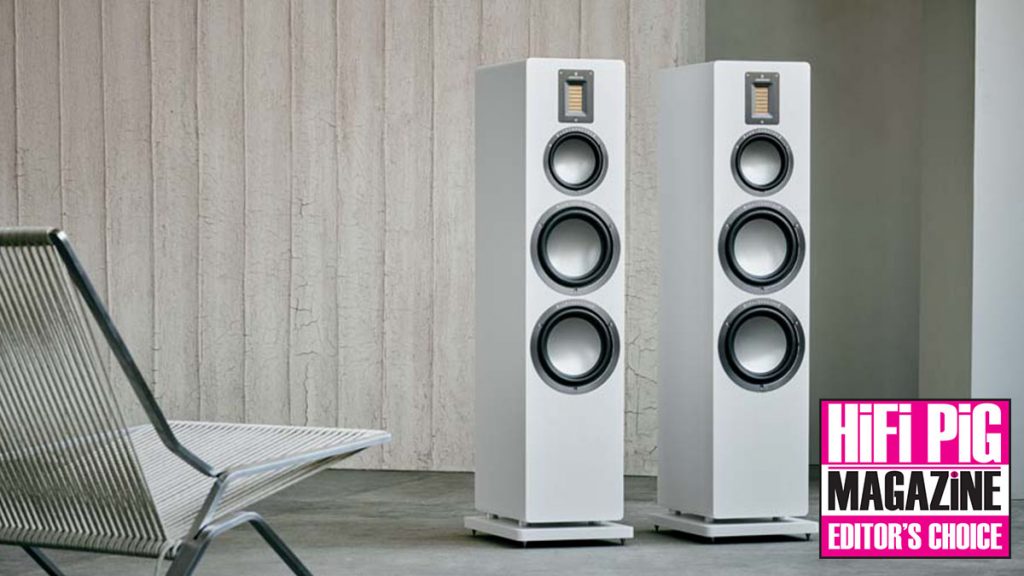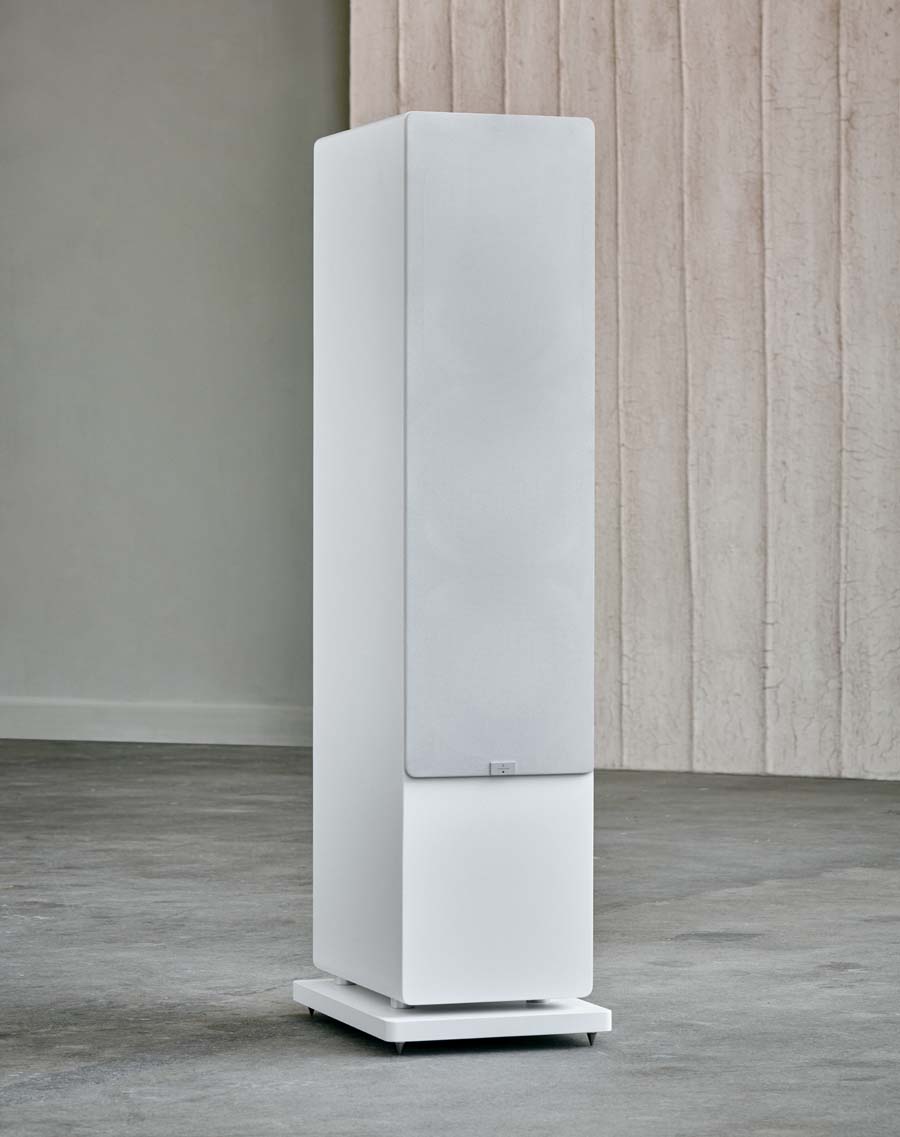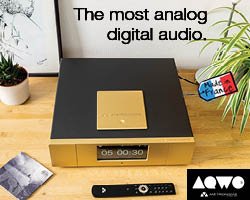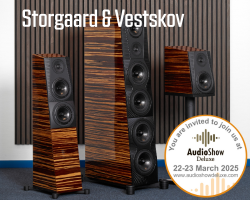AUDIOVECTOR QR7 LOUDSPEAKERS REVIEW
Danish brand Audiovector launched their QR7 £4950 floorstanding loudspeakers at High End Munich earlier this year. Stuart Smith takes a listen.
The Audiovector QR7 was one of the products I was most looking forward to seeing and hearing at Munich High End way back in May of 2022. From what I had read and been told the speakers promised to give listeners a good proportion of what the R series of speakers from this Danish brand offered but at a fraction of the cost – the QR7 has a recommended UK price tag of £4950 a pair. That still makes these a substantial investment at SRP, but by the same token it does seem to be that you are getting a good deal of loudspeaker for your money, but if they live up to the perceived promise of delivering a taste of a speaker like Audiovector’s R6 then they could well be a very attractive proposition. Indeed, when the QR7s arrived I was somewhat taken aback at the size of the boxes they arrived in – they are huge and were immediately claimed by Ali (one of the HiFi Pig cats) where he immediately became self-proclaimed “King Of The Castle”.
THE AUDIOVECTOR QR SERIES
The Audiovector QR series of loudspeakers boasts a trio of floorstanders (including the QR7) a two-way standmount, a wall-mounted two-way, a sub, and a centre channel speaker. Given the speakers in the range, it is self-evident that, at least in part, there is a home-cinema audience being targeted here, as well as the more traditional two-channel stereo users. This seems to be a sensible strategy as many folk now integrate their music systems into their home-cinema setups. The range is available in Dark Walnut, Piano Black and White Silk, the latter being the finish we have been sent for review.
AUDIOVECTOR QR7 BUILD AND FEATURES
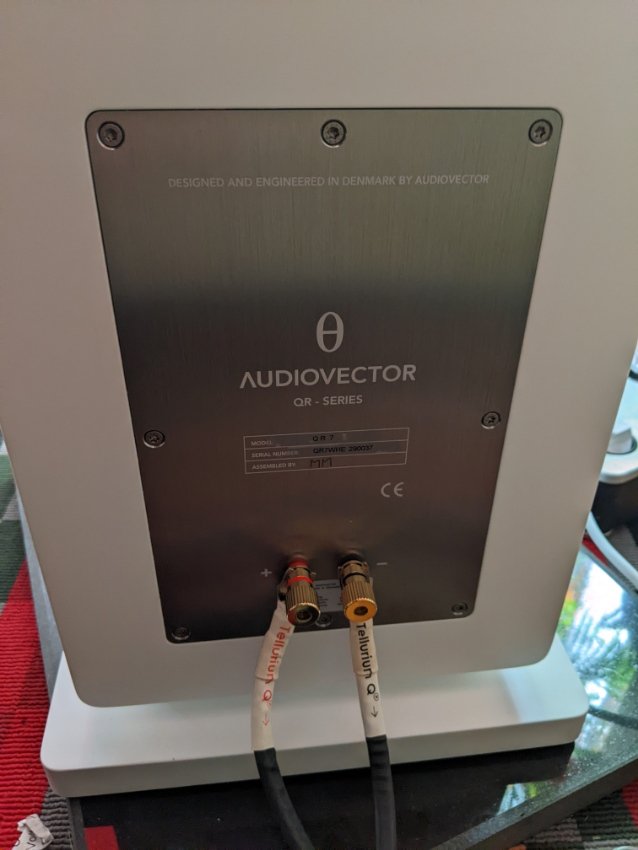
A single pair of speaker binding posts are found around the back. You can also see the space between the speaker and the plinth that allows for the downward-firing bass port.
Packaging of the speakers is excellent as you would expect and the speakers arrived without blemish. In the box are the speakers and their magnetic cloth grilles, a set of spikes for each speaker, and a small but well-formed owners’ pamphlet. I tend not to use spikes and sat the speakers directly on thick marble slabs in our main and large primary listening space, which, as regular readers will be well aware, is treated with GIK panels to offer a consistent and coherent listening space in which to test loudspeakers and other kit. On the point of spikes, I do wish all manufacturers would give an option of spikes or, perhaps, something like Sorbothane pods.
The speakers are bass reflex with a downward-firing port and, to allow them to breath into open air. the speakers are sat on an integrated plinth via four short columns to allow the soundwaves to “escape”. It is to this plinth you would attach the spikes if you use them.
Finish, as expected, is very good and thoroughly in-keeping with a speaker costing (at retail) £/€5000-ish.
This is a three-way design with the 2x eight-inch drivers firing down through that port I mentioned, a six-inch mid, and a gold leaf AMT (Air Motion Transformer) tweeter. I’ll go into a bit more detail shortly about the drivers.
Once out of their boxes and positioned correctly the speakers are large but not as overwhelmingly imposing as the boxes they arrived in would have suggested. They stand 1140mm high, 250mm wide, and 400mm deep. The speakers proved unfussy in set up and I had them about 3m apart and at least a metre from side and back walls. The listening position was 3m from the plane between the speakers and they were angled into the listening spot.
Finish is lovely in Gloss White and I didn’t bother with the magnetic grilles. They are a solid speaker under the tap test and other than a pair of binding posts round the back there’s not much more to add with respect to the build and features of the QR7s.
AUDIOVECTOR QR7 DRIVERS
I’ve written about the AMT drivers before and so I will copy and paste what I pulled from Wiki about these drivers. “The AMT was invented by Dr Oskar Heil and works in a very different transduction principle than your common or garden driver. It also works somewhat differently to ribbon loudspeakers in that the diaphragm is pleated and it uses a metal-etched sheet of metal-etched folded sheet of polyethelene terephthalate film with the etching acting as a voicecoil. The whole is then housed between four stacks of steel pole-plate pieces positioned at forty-five degrees within a high-intensity, quadratic, opposing magnetic field. The folded diaphragm works like the body of an accordion with it being pushed in and out.” I really do like an AMT driver and have found that when implemented correctly they offer up an airy and three-dimensional aspect to the upper ranges. This gives speakers I’ve heard that use them, including our Audiovector R3 and R6s, a real feeling that the tops have room to breathe and an ethereal quality – it’s difficult to describe, but I like what they bring to festivities. Anyway, the AMT on the QR7s is placed in an aluminium faceplate that has been machined, glass blasted and then anodised. The gold-plated “dispersion mesh”, I’m informed, acts as an S-Stop filter that has been inspired by pop filters used in front of microphones in recording studios to stop sibilants and plosives.
The 6” mid drivers that sits betwixt the AMT and the two bass drivers are a “Pure Piston” dual magnet affair. The idea here is that the driver works like a perfect piston over several octaves and as such claims to offer the low distortion levels found in aluminium/diamond drive units.
The two 8” bass drivers that fire down through that port at the bottom of the speakers ( and the 6″ mid) are based on a membrane that combines aluminium (for strength) with softer materials (and here I’m assuming some kind of foam) in a sandwich-style configuration – aluminium/softer material/aluminium). The goal here is to offer a very light but ultimately stiff cone for speed and to discourage it from physically distorting when playing – leading to less distortion when listening.
The frequency response is a claimed 28-52kHz and that is both very low and very high. The two eight-inch drivers go up to 425Hz where they cross over with the 6” mid unit and in themselves offer a good deal of surface area to move air, with the bass port enhancing this to lower the response. The crossover point for the mid and the AMT tweeter is 3000Hz.
The speakers are 90.5 dB sensitive and nominally 6 ohms and so should be fine with relatively modestly rated amplifiers, though I will be using our TotalDAC Amp1, which is a 2x 160W (8 Ohms) beast of an amplifier, throughout the review process.
LISTENING TO THE AUDIOVECTOR QR7 LOUDSPEAKERS
As always I ran the speakers in for a few days before sitting down to listen critically. Most of this running in was done in the main system whilst mixing up house and techno on a set of Technics 1210s – not strictly part of the review process, of course, but I found the QR7s very easy to mix on with, particularly, the hi-hats being easy to follow with one ear whilst the other was stuck to a pair of headphones listening to the other turntable’s output. The speakers also impressed here with their detailed bass, which was again easy to follow.
Listening proper was conducted over a few days where I sat and listened to the speakers using the TotalDAC amp I mentioned, Leema Libra pre/DAC and a Stack Audio streamer. The latter is attached to a well-sorted network. Some listening was done using a Technics 1200G, Hana Umami and LAB12 melto phonostage but not a great deal. Cables for the duration were Tellurium Q Silver Diamond speaker cables with Atlas mains cables and interconnects. A Torus Power mains conditioning unit was in place at all times during the listening process.
I think it’s fair to say that I did have at least some preconceived notions with regard to how these speakers would perform in the big system. My expectations were that they would be a little like the R3s we have only a bit rougher round the edges and without the final degree of finesse that the R3 and R6s from Audiovector have. I also expected their bass to be more brash and a little too overblown – and perhaps a little “one-note”.
One of the great things about this job is that we don’t have (or need) to review everything we are offered and that we only need to take products that excite us or ones that are a bit different. That may skew the apparently high level of awards we give out, but at the end of the day I don’t want to sit and listen to crap products and we are pretty confident that folk don’t want to read my thoughts on them. Anyway, I’m getting away from the review, suffice it to say that I was more than happy that we asked for these speakers for review…
A bit of low volume Ali Farka Touré’s Rouky from The Source (1991) showed the QR7s to perform well at these levels. There’s enough detail conveyed, particularly in the upper and mid registers, to give an excellent sense of movement over the fretboard of the guitar and also a feeling of space in the soundstage. Small picks on the strings and bends on the top strings of the guitar appeared high and central in the mix, whilst the (sparse) vocal was central and at ear level. Other panning, either natural or added in the final mixdown, added to the feeling that I was listening to a speaker that had been carefully voiced to give a sense of space, and to be fair the AMT tweeter was always going to give this effect. I make no apology for saying that a well-implemented AMT tweeter is my favoured way to give a natural, if extended, sense of space and to a speaker’s performance. This relatively simple recording sounded excellent at low volume, though I did feel the bottom bass string on the guitar wasn’t as well represented as the top.
Without touching the volume knob I put on The Les Claypool Frog Brigade’s Riddles Are Abound Tonight from Live Frogs. This is pretty complex tuneage and the music (obviously) revolves around the bass guitar of Claypool. The bass does come across pretty well at this low level. It’s a balanced sound overall that is underpinned by the rhythm section which is rendered tight and fast with no bass overhang or bloat. To be fair, if a speaker is exhibiting slack-sounding bass at this kind of volume they’d not last long in this house. As I said, there’s a lot going on in this tune, but the QR7s make good sense of what’s happening and it’s an enjoyable and foot-tappingly fun experience. This is a live record (the clue is in the title, though it’s not real frogs playing) and that is conveyed through the speakers, though I can’t help but want to crank the volume up a good bit – playing tunes on the two Technics players, I also found that over the space of a couple of hours I’d gradually increase the volume, though I don’t think this is particularly unusual a trait as our ears become accustomed to volume. Actually, I was really impressed with these speakers played at volumes that I’d call “Sunday morning chilling” levels. There is a lot going on here and the speakers make good sense of getting it across to the listener.
Why I don’t know, but Roon threw up Antonio Caldera Trio Sonatas which really isn’t on my usual listening fodder, but again the speakers made very good sense of the strings at low levels with me having a good sense of the musicians laid out in front of me – again, it’s that perception of space. My only quibble here was that I felt that I lost a little of the lower strings in the soundstage and that the recording lacked a bit of oomph. I’m not overly familiar with this record on my virtual shelf, but think it’s worth mentioning my experience here.
BBC Radio 4 had voices sounding natural and central between the loudspeakers. Voices in the studio were obviously lacking effects of the studio space given they are close mic’d, but when switching to interviewees outside the studio it was clear they were in a different space and there was a good degree of the “room” evident. I found that playing speech radio at normal speaking volumes it was easy to have a conversation without the radio taking over and becoming overbearing and obtrusive. This is an interesting point and one that I am noting more and more when in the company of a quality loudspeaker – less good loudspeakers seem to get in the way of conversation, but the better a speaker is the less it seems to impact on having a chat. I don’t fully understand why this is, but I am guessing that this is a factor of our brains picking up and being distracted by unnatural distortions in lesser-performing speakers. Anyway, the QR7s didn’t get in the way.
So far these speakers remind me more of the R6 (28K) as opposed to the R3 (10K) and that is surely a good sign that Audiovector has got things right.
Right, time to up the ante and also the volume with the excellent Bionaut and Everybody’s Kissing Everyone. I picked this track out because it has a very specific bass sound – I don’t know what synth it is but it’s one used a lot on earlier house productions. There’s an effortlessness to the bass here and whilst it’s fast and tight enough I can’t help feeling that it’s a little further back in the mix for my own personal tastes with the QR7s when there’s lots going on around it. However, when the bass takes (literally) centre stage and is playing without much else going on it sounds fab. This is an area where both the R3 and R6 are better loudspeakers than the QR7s, for sure – but so they should be given their higher price. I’m not really suggesting there’s much wrong with the bass, it just isn’t AS coherent and separated in the mix as with the other two loudspeakers I mention. Paris’ Guerrilla Funk (Deep Fo’ Reel Mix) is a G-Funk tune and again I feel the bass is a little far back in the mix when compared to, for example, our Total DAC D100s. This is not unexpected given the speakers are half the price and that the D100s have an excellent and extended bass response in sealed cabinets. This balance may be a good thing for many rooms in that an extended bass response (when compared to the volume of other aspects of a speaker’s sound) can become too much and over-excite smaller rooms. Perhaps this was a deliberate design element for the QR7s to make them more adaptable and more suitable for more living spaces – possibly not an unwise move! Getting a speaker “right” is a fine balancing act and at this price, I assume the objective is to make the QR7 a speaker to appeal to as many people as possible in as many rooms as possible, and whilst they are a big speaker, this slightly toned back response will allow them to work in smaller spaces where, for example, the R6 just will not. I can crank Tantra’s Hills Of Katmandu (Original Album Version) up very loud and the bass does not become overbearing or too much for the room, though we have it very well treated in this respect. Percussion sounded really nice on this track with these speakers and the deliberate hard left and right panning of some of the instruments was clear, though the bass and kick remained central in the image.

The right-hand speaker with an Avantgarde Duo XD in the background gives you a sense of their scale.
At volume and with regards to bass, these are a fun and well-balanced speaker that I could certainly live with, my only criticism being that they may be a little polite in a well-treated or big room – in a normal-sized living space with normal furnishings I think they will be excellent in the bass department. Your taste may be different and find this slightly toned-back bass is more to your liking.
On everything I listened to and mentioned above I found that the upper frequencies had that AMT air and that they performed really well through the mid-band and upper-bass. I also noted that these will go very loud – louder than I would be comfortable with for long periods – without sounding distorted or that they are being pushed too hard…and they do come alive a little more when pushed a bit.
Now, listening to Perth Drug Legend’s This is Tulloch Not Tibet, Pal, again at volume, I get the bass going low and deep, but also that it is not pushed too much with regards to the other sounds in the mix when played on the QR7s. The sound overall is not as lineated as with the R3 or R6, but the bass does go down lower (I feel than the R3s that sound more refined/polite in this area). This sounds like I’m contradicting myself a bit but the bass does go low but I also feel it is kept a little back in the overall way the speakers sound.
A lot of people are going to buy these for the AMT tweeter and what it brings to the party by way of creating a sense of space and staging. In this respect the QR7s really are brilliant and I can’t help but think that they offer a lot of what the R6 offers, and with this in mind I thoroughly believe that you are looking at a speaker that seems to offer, given my experience with them and comparing them directly to the R6, a bit of a bargain. I cannot compare the QR7s directly speakers in the same price bracket as I just don’t have them to hand and my aural memory isn’t as good as some reviewers may claim theirs to be and I’m not going to pretend I can recall accurately how speaker X, Y or Z sounded from months or even years ago.
Emiliani Torrini’s Fisherman’s Woman album is an older record but is really nicely recorded. She has a distinctive vocal and so this record offers a good opportunity to see how these speakers perform, again at decent volume levels, through the mid-band. The opening track Nothing Brings Me Down plays to these speakers’ strengths. The record is vocal and has a bit of guitar and effects and is simply but well produced. Torrini’s vocal really does come across as pure when she extends a note and the slightly nasal aspect to her style comes across really well ( I think she sounds a good deal like Nick Drake, though she is Icelandic/Italian – I looked her heritage up on Roon and oddly they too say she “brings to mind the charming work of Nick Drake”). Guitar, like her voice, is very nicely produced and there is detail as moves across the fretboard. This is a relaxed and chilled record that the QR7s play really well. This is another feather in the cap of these speakers and proof to me that they are able to play a wide variety of music very well. Again, this is a sensible move on the part of Audiovector in that they will appeal to people who are into their music and live in real-world spaces.
I put a lot of music through these speakers in a relatively short time (over and above the run-in period) and I thoroughly enjoyed them. And they really do remind me a lot of the Audiovector R6s but at less than a fifth of the price. That is a hearty recommendation, but, as always, I thoroughly recommend you go out and listen to these speakers in comparison to others in this price range before you go and hand your dosh over – all I can do, and all any reviewer can do is try to offer an idea of their sound in comparison to the other products they have to hand by which to draw a comparison.
QUIBBLES
Bass is a little far back in the balance in our room.
They are large loudspeakers.
Black, white or one wood finish are your options.
Do not throw as wide a soundstage in comparison to the speakers we have for reference
CONCLUSION
This is a well-considered and well-thought-out product that will appeal to a lot of music lovers. They are a very musically accomplished speaker across the board and Audiovector have, to my ears, made sensible decisions with regards to their overall balance. They have erred on the side of caution with regards to the balance of the bass when compared to the other aspects of the speaker and this will make it more acceptable and useful in more listening environments.
What you get is a speaker that performs well at low volume (a good thing) but one that likes to be pushed – and this is where the speakers come alive a little more. However, if you like that Sunday morning feel at a low level then these are lovely sounding speakers – chilled and not over demanding a listen.
They do not disappear as much as the R3 or R6 and (particularly) the width of the soundstage is not as extended as these speakers, but they do offer a degree of height to the soundstage. Front to back performance of the stage image is also not as pronounced as with these other two speakers – it’s fairly linear between the speakers with the feeling that you are a little further back in the (imagined) concert hall.
Would I buy them? I would certainly have these speakers on my radar if I was in the market for a five grand speaker, with the caveat that I do think they deserve to be partnered with quality electronics – our TotalDAC Amp1 suited them really nicely with its slightly warmer presentation, but they also responded well to our Krell KST100, though the latter is a leaner and more incisive sounding amp which comes through well on the QR7s. Again, I suggest trying to get an audition with your own amplifier and preferably in your own home!
Do I think they are an Audiovector R6 on the cheap? I sort of do, yeah. They lack the overall refinement of the R6, but they also offer a taste of that speaker’s upper and mid balance, though they don’t have the same oomph that the R6s isobaric bass has – by oomph, I mean dynamics in the bass. They are more of an R3 on a budget, though again they are not as absolutely refined as these speakers. With that said, they are speedy and relatively uncoloured so as to offer a very good feeling of small details of instruments’ individual character and vocalists’ style/inflections.
We did have a conversation and that conversation went a little like this; Should we sell the R6s and buy a pair of these and a nice car? The unanimous decision was a resounding “NO WAY!” However, were we in the market for a pair of R3s and had the QR7s to listen to at the same time, I think the decision would be a lot tougher.
In comparison to the Raidho X1T (€5800) speakers we had running at the same time in the second listening space, they do not have the same level of refinement with regards to soundstaging and imaging, and nor are they as absolutely uncoloured through the mid and upper-mids. Conversely, the QR7s go lower and do not need a sub in a larger room, though they are more imposing and take up a bit more real-estate – but then you have to spend extra if you want the dedicated stands for the Raidhos. He giveth and he taketh away!
Overall the QR7s are a very nicely balanced loudspeaker that has been sympathetically tuned to appeal to a wide audience and real-world listening spaces. I really liked them a lot.
I sat on this review for a full 24 hours before deciding on the award I’d give them and I think my decision needs explaining a little – even after 24 hours I’m still not 100% certain. However, they get our top award based on the fact that they offer a good degree of what the more expensive speakers (R3 and R6) from Audiovector bring and both those rightly got our top award. The recently reviewed Raidhos are a better speaker in many ways, particularly through the mids, tops and with regards to soundstaging, but may well require a sub for larger rooms and don’t come with a dedicated stand (extra cost) and they too got our top award. So, despite having handed out a number of our Editor’s Choice awards recently, these too get the award.
AT A GLANCE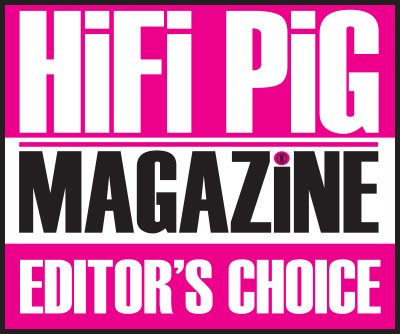
Build And Features:
Nicely finished, though pretty limited finish-palette
Quite a big speaker
Easy to position with their downward firing port
Seems to be a lot of speaker for the asking price
Sound Quality:
Well balanced
Relatively uncoloured
Exciting and fairly dynamic
Good soundstaging but not on a par with the more expensive R3, R6 from Audiovector or the Raidho X1Ts
Do not “disappear” when compared to the speakers we had to compare them to
Non-fatiguing but detailed
Bass goes low but is not as forward or pronounced as it could be for my taste
Value For Money:
I can’t fault these speakers with regards to what they are asking and when compared to their more expensive stablemates
We Loved:
Unfussy positioning and well-balanced sound that makes sensible compromises
We Didn’t Love So Much:
Bass a little restrained for my taste
Soundstage is not as wide or deep as others, though it has good height
Price: £4950, €5700, $6500
Elevator Pitch Review: Danish brand Audiovector’s QR7 is a large three-way, bass reflex-loaded floorstanding loudspeaker that incorporates an AMT tweeter and drivers made of an aluminium/softer material sandwich. They offer a good balance across the frequency range and are particularly accomplished through the mids and tops, though I found the bass to be a little reserved for my taste in this room. They certainly offer a good taster of what speakers much further up the Audiovector price range offer at a fraction of the price and as such offer good value for money if you can accommodate their size. I highly recommend a properly conducted listening test with your own amplifier before buying!
Stuart Smith
Review System: Technics 1200G, Hana Umami, Lab12 melto phonostage. Leema Libra DAC/Pre and TotalDAC AMP1 amplifier. Stack Audio streamer. Torus Power mains conditioner plus Tellurium Q and Atlas Cables.
















































